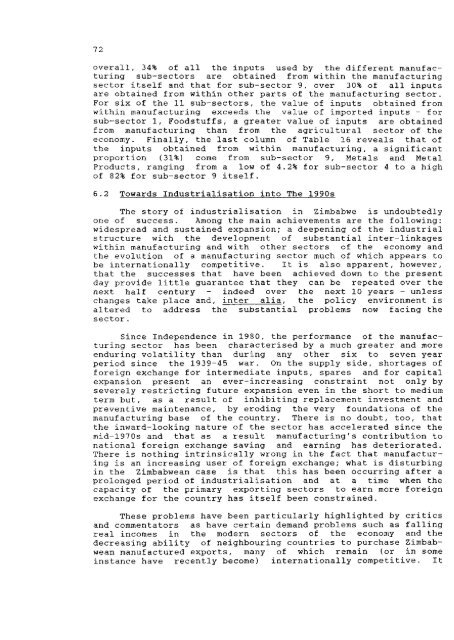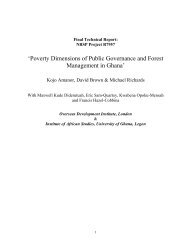Zimbabwe - Overseas Development Institute
Zimbabwe - Overseas Development Institute
Zimbabwe - Overseas Development Institute
You also want an ePaper? Increase the reach of your titles
YUMPU automatically turns print PDFs into web optimized ePapers that Google loves.
o v e r a l l , 34% of a l l the inputs used by the d i f f e r e n t manufact<br />
u r i n g sub-sectors are obtained from w i t h i n the manufacturing<br />
sector i t s e l f and that f o r sub-sector 9, over 30% of a l l inputs<br />
are obtained from w i t h i n other parts of the manufacturing sector.<br />
For s i x of the 11 sub-sectors, the value of inputs obtained from<br />
w i t h i n manufacturing exceeds the value of imported inputs - f o r<br />
sub-sector 1, Foodstuffs, a greater value of inputs are obtained<br />
from manufacturing than from the a g r i c u l t u r a l sector of the<br />
economy. F i n a l l y , the l a s t column of Table 16 reveals that of<br />
the inputs obtained from w i t h i n manufacturing, a s i g n i f i c a n t<br />
proportion (31%) come from sub-sector 9, Metals and Metal<br />
Products, ranging from a low of 4.2% f o r sub-sector 4 to a high<br />
of 82% f o r sub-sector 9 i t s e l f .<br />
6.2 Towards I n d u s t r i a l i s a t i o n i n t o The 1990s<br />
The story of i n d u s t r i a l i s a t i o n i n <strong>Zimbabwe</strong> i s undoubtedly<br />
one of success. Among the main achievements are the f o l l o w i n g :<br />
widespread and sustained expansion; a deepening of the i n d u s t r i a l<br />
s t r u c t u r e with the development of s u b s t a n t i a l i n t e r - l i n k a g e s<br />
w i t h i n manufacturing and with other sectors of the economy and<br />
the e v o l u t i o n of a manufacturing sector much of which appears to<br />
be i n t e r n a t i o n a l l y competitive. I t i s also apparent, however,<br />
that the successes that have been achieved down to the present<br />
day provide l i t t l e guarantee that they can be repeated over the<br />
next h a l f century - indeed over the next 10 years - unless<br />
changes take place and, i n t e r a l i a , the p o l i c y environment i s<br />
a l t e r e d to address the s u b s t a n t i a l problems now f a c i n g the<br />
sector .<br />
Since Independence i n 1980, the performance of the manufact<br />
u r i n g sector has been c h a r a c t e r i s e d by a much greater and more<br />
enduring v o l a t i l i t y than during any other s i x to seven year<br />
period since the 1939-45 war. On the supply side, shortages of<br />
f o r e i g n exchange f o r intermediate inputs, spares and f o r c a p i t a l<br />
expansion present an e v e r - i n c r e a s i n g c o n s t r a i n t not only by<br />
severely r e s t r i c t i n g future expansion even i n the short to medium<br />
term but, as a r e s u l t of i n h i b i t i n g replacement investment and<br />
preventive maintenance, by eroding the very foundations of the<br />
manufacturing base of the country. There i s no doubt, too, that<br />
the inward-looking nature of the sector has accelerated since the<br />
mid-1970s and that as a r e s u l t manufacturing's c o n t r i b u t i o n to<br />
n a t i o n a l f o r e i g n exchange saving and earning has d e t e r i o r a t e d .<br />
There i s nothing i n t r i n s i c a l l y wrong i n the f a c t that manufacturing<br />
i s an i n c r e a s i n g user of f o r e i g n exchange; what i s d i s t u r b i n g<br />
i n the <strong>Zimbabwe</strong>an case i s that t h i s has been o c c u r r i n g a f t e r a<br />
prolonged period of i n d u s t r i a l i s a t i o n and at a time when the<br />
capacity of the primary exporting sectors to earn more f o r e i g n<br />
exchange f o r the country has i t s e l f been constrained.<br />
These problems have been p a r t i c u l a r l y h i g h l i g h t e d by c r i t i c s<br />
and commentators as have c e r t a i n demand problems such as f a l l i n g<br />
r e a l incomes i n the modern sectors of the economy and the<br />
decreasing a b i l i t y of neighbouring countries to purchase <strong>Zimbabwe</strong>an<br />
manufactured exports, many of which remain (or i n some<br />
instance have r e c e n t l y become) i n t e r n a t i o n a l l y competitive. I t
















